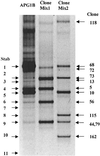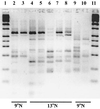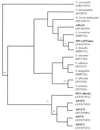Characterization of a novel spirochete associated with the hydrothermal vent polychaete annelid, Alvinella pompejana
- PMID: 11133434
- PMCID: PMC92526
- DOI: 10.1128/AEM.67.1.110-117.2001
Characterization of a novel spirochete associated with the hydrothermal vent polychaete annelid, Alvinella pompejana
Abstract
A highly integrated, morphologically diverse bacterial community is associated with the dorsal surface of Alvinella pompejana, a polychaetous annelid that inhabits active high-temperature deep-sea hydrothermal vent sites along the East Pacific Rise (EPR). Analysis of a previously prepared bacterial 16S ribosomal DNA (rDNA) library identified a spirochete most closely related to an endosymbiont of the oligochete Olavius loisae. This spirochete phylotype (spirochete A) comprised only 2.2% of the 16S rDNA clone library but appeared to be much more dominant when the same sample was analyzed by denaturing gradient gel electrophoresis (DGGE) and the terminal restriction fragment length polymorphism procedure (12 to 18%). PCR amplification of the community with spirochete-specific primers used in conjunction with DGGE analysis identified two spirochete phylotypes. The first spirochete was identical to spirochete A but was present in only one A. pompejana specimen. The second spirochete (spirochete B) was 84.5% similar to spirochete A and, more interestingly, was present in the epibiont communities of all of the A. pompejana specimens sampled throughout the geographic range of the worm (13 degrees N to 32 degrees S along the EPR). The sequence variation of the spirochete B phylotype was less than 3% for the range of A. pompejana specimens tested, suggesting that a single spirochete species was present in the A. pompejana epibiotic community. Additional analysis of the environments surrounding the worm revealed that spirochetes are a ubiquitous component of high-temperature vents and may play an important role in this unique ecosystem.
Figures




References
-
- Alayse-Danet A M, Desbruyères D, Gaill F. The possible nutritional or detoxification role of the epibiotic bacteria of alvinellid polychaetes: review of the current data. Symbiosis. 1987;4:51–62.
-
- Alayse-Danet A M, Gaill F, Desbruyères D. In situ bicarbonate uptake by bacteria-Alvinella associations. Mar Ecol (Pubbl Stn Zool Napoli I) 1986;7:233–240.
Publication types
MeSH terms
Substances
Associated data
- Actions
LinkOut - more resources
Full Text Sources

